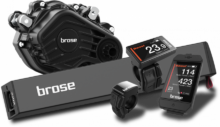7 Steps to success
 In the 41 years that I have been in the sales game I have heard and read about many systematic steps in a sales procedure. They seem to vary from 6-10 steps. I grew up under a 7-step procedure and have been teaching it for the past 30 years.
In the 41 years that I have been in the sales game I have heard and read about many systematic steps in a sales procedure. They seem to vary from 6-10 steps. I grew up under a 7-step procedure and have been teaching it for the past 30 years.
In the 1980s many motorcycle dealerships referred to it as the “Lemco Procedure,” but my brother Ed and I did not invent it; we just borrowed it. The 7-step procedure has been around ever since someone tried to trade their old camel in for a new one. The 7 steps are:
Step 1 – Greet
Step 2 – Probe
Step 3 – Sit on Bike
Step 4- Presentation/Demonstration
Step 5 – Sit at Desk
__________________
Step 6 – Write-Up
Step 7 – Close
When I write the steps on the white-board I draw a line under Step 5. I explain that the first five steps are something that they should always be able to do and hopefully always be in control of.
Step 1—Greet: Nobody will want to complain to the manager that a salesman said hello to them.
Step 2—Probe: Nobody will complain to the manager that after they said just looking, the salesperson asked which models they were interested in.
Step 3—Sit on Motorcycle: Nobody will complain to the manager that they were asked if they would like to sit on the motorcycle they were looking at.
Step 4—Presentation/Demo: Nobody will complain to the manager if someone gave them a presentation about the model they were interested in or asked if they would like to take it on a test ride.
Step 5—Sit at Desk: Nobody will complain to the manager that the salesman wanted to sit down for a minute to go over the details. If the customer was going to leave after going over the details the desk is where the salesperson should give the customer their card and not standing up on the showroom floor.
Steps 1-5 are 100 percent in the salesperson’s control and how well salespeople do them will have a lot to do with the outcome of the sale. When it comes time for Step 6—The Write-Up, customera must be sold on the first five steps. They must feel comfortable that they are making the right buying decision at the right location from the right person. The show the salesperson gives will have everything to do with that decision.
It is very important to me that the people at the training believe in the sales philosophy as much as they do the sales procedure. I explain that if the show was not very important, we would just put brochures on the motorcycles. If the customer wanted to buy one, then they would just roll it up to the counter to pay for it.
The whole reason that we have salespeople is to give shows. We need them to be entertaining and informative, and we need to stay in control by taking the sale one step at a time. There is no leaping over steps because the salesperson is trying to get somewhere in a hurry. Speed selling will lose more deals than it will make. Every customer deserves a full and total command performance.
This is the 12th part in a series of blogs about hiring new salespeople. To read the previous blogs in this series, click here.
Steve Lemco is the youngest brother of the late Ed Lemco and has been doing sales training and hiring for motorcycle dealers since 1983. He is the author of three sales books, the new “Training and Hiring New Salespeople,” “Motorcycle Sales Made Easy” and “You Gotta-Wanna.” Steve has trained in every state in the U.S., as well as England, France, Australia and New Zealand. Steve incorporates motivational boards and games along with his training and hiring because he believes the best way to get the job done is to make it fun.
Contact: stevelemco@aol.com
Website: www.stevelemco.com
Phone: 253/826-6110






Good article. Of course it also takes a salesman with personality and a passion for the industry to be successful. Bravo on precise methodology.